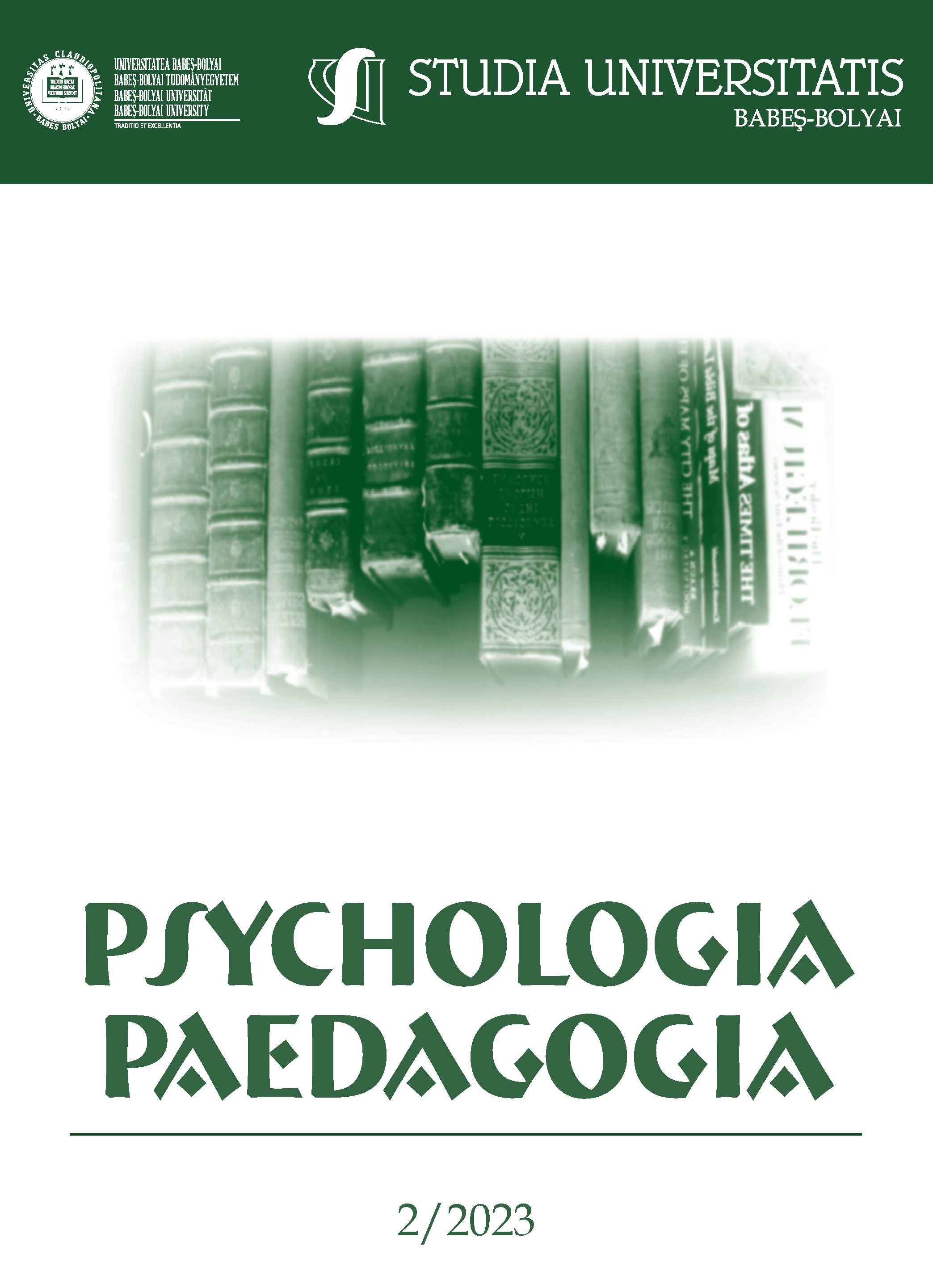The association between Time Perspective and Death Anxiety in Elderly: a systematic review of quantitative studies
DOI:
https://doi.org/10.24193/subbpsyped.2023.2.02Keywords:
time perspective, death-anxiety, elderly, old age.Abstract
This systematic review aims to investigate the literature on the relationship between time perspective and death anxiety in the elderly population. Time perspective is a fundamental process by which the flow of personal experiences is categorized into temporal dimensions, while death anxiety refers to the fear associated with the inevitability of death. The review systematically assesses and critically discusses the literature on time perspective and death anxiety and highlights the implications for future research and practice. A comprehensive search of relevant databases (PubMed, Web of Science, Scopus, Science Direct) was conducted to identify quantitative studies published up to date in this review. The initial search yielded a considerable number of studies (N=401). After applying rigorous inclusion criteria, a final selection of studies (N=5) was examined in detail. Results of our systematic review show that time perspective is related to death anxiety in some circumstances, but extensive research is needed to explore this relationship. Future research efforts should focus on refining assessment methodologies from time perspective and investigating potential interventions that can alleviate death anxiety among the elderly population. Understanding the interplay between time perspective and death anxiety may hold valuable implications for mental health interventions and geriatric care, promoting enhanced well-being and psychological resilience in later life.
References
Barber, S. J., & Tan, S. C. (2018). Ageism affects the future time perspective of older adults. GeroPsych. https://doi.org/10.1024/1662-9647/a000189
Bascue, L. O., & Lawrence, R. E. (1977). A study of subjective time and death anxiety in the elderly. OMEGA-Journal of Death and Dying, 8(1), 81-90.
Brandtstädter, J., & Rothermund, K. (2003). Intentionality and time in human development and aging: Compensation and goal adjustment in changing developmental contexts. In U. M. Staudinger & U. Lindenberger (Eds.), Understanding human development: Dialogues with lifespan psychology (pp. 105–124). Dordrecht, the Netherlands: Kluwer. http://dx.doi.org/10.1007/978-1-4615-0357-6_6
Brandtstädter, J., Rothermund, K., Kranz, D., & Kühn, W. (2010). Final decentrations: Personal goals, rationality perspectives, and the awareness of life’s finitude. European Psychologist, 15(2), 152–163. https://doi.org/10.1027/1016-9040/a000019
Cameron, P., Desai, K. G., Bahador, D., & Dremel, G. (1978). Temporality across the life-span. The International Journal of Aging and Human Development, 8(3), 229–259. https://doi.org/10.2190/2V1R-UJBN-QNT5-EX4A
Carstensen, L. L., & Lang, F. R. (1996). Future Orientation Scale. Unpublished manuscript, Standford University.
Carstensen, L. L. (2006). The influence of a sense of time on human development. Science, 312(5782), 1913–1915.
http://dx.doi.org/10.1126/science.1127488
Chen, S. M. E. (2011). Time perspective, death anxiety and emotional regulation processes in older adults. http://dspace.cityu.edu.hk/handle/2031/6436
Cottle, T. J. (1976). Perceiving time: A psychological investigation with men and women. Wiley & Sons.
Crumbaugh, J. C., & Maholick, L. T. (1964). An experimental study in existentialism: The psychometric approach to Frankl's concept of noogenic neurosis. Journal of clinical psychology, 20(2), 200-207.
https://doi.org/10.1002/1097-4679(196404)20:2<200::AID-JCLP2270200203>3.0.CO;2-U
Dickstein, L. S., & Blatt, S. J. (1966). Death concern, futurity, and anticipation. Journal of consulting psychology, 30(1), 11. https://doi.org/10.1037/h0022904
Ebner, N. C., Freund, A. M., & Baltes, P. B. (2006). Developmental changes in personal goal orientation from young to late adulthood: From striving for gains to maintenance and prevention of losses. Psychology and aging, 21(4), 664–678. http://dx.doi.org/10.1037/0882-7974.21.4.664
Fortner, B.V., & Neimeyer, R. A. (1999). Death anxiety in older adults: A quantitative review. Death Studies, 23(5), 387–411.
https://doi.org/10.1080/074811899200920
Fung, H. H., & Isaacowitz, D. M. (2016). The role of time and time perspective in age-related processes: Introduction to the special issue. Psychology and Aging, 31(6), 553-557. https://doi.org/10.1037/pag0000119
Guy, B. S., Rittenburg, T. L., & Hawes, D. K. (1994). Dimensions and characteristics of time perceptions and perspectives among older consumers. Psychology & Marketing, 11(1), 35–56. https://doi.org/10.1002/mar.4220110106
Henrie, J. A. (2010). Religiousness, future time perspective, and death anxiety among adults. West Virginia University.
James, W. (1950). The principles of psychology. New York, NY: Dover Publications.
Jones, J. M. (1988). Cultural and individual differences in temporal orientation. In J. McGrath (Ed.), Research toward a social psychology of time (pp. 21–38). Beverly Hills, CA: Sage Publications.
Josey, C. C. (1950). A scale of religious development. American Psychologist, 5, 281.
Kastenbaum, R. (1961). The dimensions of future time perspective, an experimental analysis. The Journal of general psychology, 65(2), 203-218. https://doi.org/10.1080/00221309.1961.9920473
Lang, F. R., & Carstensen, L. L. (2002). Time counts: future time perspective, goals, and social relationships. Psychology and Aging, 17(1), 125–139. http://doi.org/10.1037/0882-7974.17.1.125
Laureiro-Martinez, D., Trujillo, C. A., & Unda, J. (2017). Time perspective and age: A review of age associated differences. Frontiers in psychology, 8, 101. https://doi.org/10.3389/fpsyg.2017.00101
Martz, E., & Livneh, H. (2003). Death anxiety as a predictor of future time orientation among individuals with spinal cord injuries. Disability and Rehabilitation, 25(18), 1024-1032. https://doi.org/10.1080/09638280310001596469
Montepare, J. M. (2009). Subjective age: Toward a guiding lifespan framework. International Journal of Behavioral Development, 33(1), 42-46. https://doi.org/10.1177/0165025408095551
Ortuño, V.E.C., Paixão, M.P., Janeiro, I.N. (2017). Qualitative and Quantitative Trends in the Assessment of Subjective Temporality. In: Kostić, A., Chadee, D. (eds) Time Perspective. Palgrave Macmillan, London. https://doi.org/10.1057/978-1-137-60191-9_8
Quinn, P. K., & Reznikoff, M. (1985). The relationship between death anxiety and the subjective experience of time in the elderly. The International Journal of Aging and Human Development, 21(3), 197-210. doi:10.2190/57D4-NUJQ-G4K1-NBC7
Rappoport, H., Fossler, R. J., Bross, L. S., & Gilden, D. (1993). Future time, death anxiety, and life purpose among older adults. Death Studies, 17, 369–379. https://doi.org/10.1080/07481189308252631
Rappaport, H., Enrich, K., & Wilson, A. (1985). Relation between ego identity and temporal perspective. Journal of Personality and Social Psychology, 48(6), 1609–1620. https://doi.org/10.1037/0022-3514.48.6.1609
Roos, P. (1964). Time reference inventory. Austin State School.
Rupprecht, F. S., Martin, K., Kamin, S. T., & Lang, F. R. (2022). COVID-19 and perceiving finitude: Associations with future time perspective, death anxiety, and ideal life expectancy. Psychology and Aging, 37(2), 260–271. https://doi.org/10.1037/pag0000661
Templer, D. I. (1970). The construction and validation of a death anxiety scale. The Journal of general psychology, 82(2), 165-177.
Downloads
Published
How to Cite
Issue
Section
License
Copyright (c) 2023 Studia Universitatis Babeș-Bolyai Psychologia-Paedagogia

This work is licensed under a Creative Commons Attribution-NonCommercial-NoDerivatives 4.0 International License.





